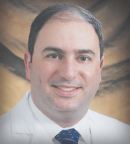Ajay K. Nooka, MD, MPH, Professor in the Department of Hematology and Medical Oncology at Emory University, and Dan Vogl, MD, MSCE, Associate Professor of Medicine at the Hospital of the University of Pennsylvania, shared their thoughts on the PERSEUS trial for The ASCO Post.

Ajay K. Nooka, MD, MPH

Dan Vogl, MD, MSCE
Dr. Nooka noted that identifying the optimal benefit of a quadruplet induction regimen for the treatment of patients with transplant-eligible newly diagnosed multiple myeloma “has been a decade-long pursuit.” The addition of the CD38 monoclonal antibody daratumumab to the triplet induction regimen of bortezomib, lenalidomide, and dexamethasone (D-VRd) in the randomized phase II GRIFFIN trial resulted in deeper responses and higher rates of measurable residual disease (MRD) negativity (at 10−5), and it prevented early relapses, based on the 4-year progression-free survival rate of 87% with D-VRd vs 70% with VRd (P < .001). Yet, despite these “convincing benefits” shown for quadruplets, the lack of data from prospective randomized controlled trials precluded their larger adoption across the board. “In this context, the long-awaited results from the phase III PERSEUS trial confirmed the benefit of quadruplets over triplets, showing significant improvement in progression-free survival and in all the secondary endpoints as well with D-VRd,” he said. PERSEUS “clearly demonstrated” that the addition of daratumumab resulted in deeper responses that translated to a better 4-year progression-free survival rate (84.3% vs 67.7%; P < .001), higher rates of MRD negativity at 10−5 (75.2% vs 47.5%), and decreased early mortality (9.7% vs 12.7%), without compromising safety. More importantly, sustained MRD negativity at 12 months (64.8% vs 29.7%) was more than doubled with quadruplets, Dr. Nooka said.
“At ASH 2023, my colleague Nisha Joseph, MD, presented Emory’s institutional data on 326 patients treated with quadruplet induction, comparing it to Emory’s historical data for triplets [see sidebar on page 7] to validate the benefit of incorporating daratumumab in newly diagnosed patients. Quadruplets resulted in deeper responses that translated to a better 4-year progression-free survival rate—85% vs 61% (P < .001)—similar to what was reported in GRIFFIN and PERSEUS. It is impressive to see the real-world data validated the results of PERSEUS, and D-VRd delivered similar outcomes,” he said.
Remaining Questions
Dr. Vogl offered a note of caution, pointing to some questions that remain unanswered about the use of upfront daratumumab. “In coming years, we will see other trials bringing highly active agents into early lines of myeloma therapy, and we need to carefully consider which endpoints are useful in studies of how therapies are sequenced in this incurable cancer. Until now, most changes in our standard of care have been based on studies showing improvements in overall survival. These include trials comparing autologous transplant to no transplant, adding bortezomib to lenalidomide and dexamethasone, adding daratumumab to lenalidomide and dexamethasone, and comparing lenalidomide maintenance after transplant to no maintenance,” he pointed out.
“Daratumumab has single-agent efficacy and a proven overall survival benefit in later lines of therapy, so we already know it is a highly effective antimyeloma agent. The real question is whether including daratumumab in initial therapy and as posttransplant maintenance should be the standard of care for all patients with newly diagnosed disease. Daratumumab clearly is associated with higher rates of cytopenias and infections and carries a substantial financial burden,” Dr. Vogl noted.
“So, could it be used just as effectively as part of second- or third-line therapy without sacrificing the one truly beneficial long-term outcome, which is overall survival?” Dr. Vogl asked. “A progression-free survival endpoint for a trial in which patients receive only one line of therapy does not answer the sequencing question of whether all patients need to receive daratumumab in their initial line of therapy.”
DISCLOSURE: Dr. Nooka reported financial relationships with Aduro Biotech, Amgen, Arch Oncology, Bristol Myers Squibb, Cellectis, Genentech, GlaxoSmithKline, Janssen, Karyopharm, Kite Pharma, Merck, Pfizer, Takeda, Adaptive Biotechnologies, BeyondSpring, Cellectar Biosciences, Oncopeptides, ONK Therapeutics, Sanofi, and Secura Bio. Dr. Vogl reported financial relationships with Sanofi, Genentech, Takeda, GSK, Active Biotech, AbbVie, and Karyopharm.

